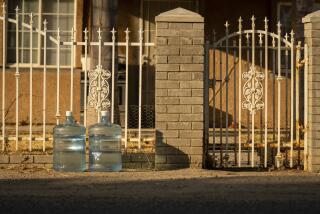Save, recycle and innovate
- Share via
Re “Hard water,” editorial, April 7
While The Times is absolutely on the mark to point out the insanity of “paper water,” it appears to overlook the mathematical impossibility of household water savings as a solution to California’s water problem.
The California Department of Water Resources statistics show that all households, and all cities and state industry, in total use just 20% of California’s water. Agriculture uses the remaining 80%, where it is wasted egregiously.
If all of the households, cities and industry reduce their water use 10%, it frees up 2% of California’s water. If agriculture frees up 10% of its water use, the supply increases four times as much, or 8%. Any water plan that does not start with this basic math will never solve California’s water problem.
James W. Taylor
San Clemente
--
The Times’ editorial calls for an end to suburban development as a fix for our water problems, offering no better a solution than would be a call for the clouds to drop more rain. Neither is realistic.
People have a right to choose the suburbs, and their new suburban home will use much less water inside than an older urban home. As for lawn irrigation, which The Times rightly sees as a water-waster, solutions The Times refers to as “potential” already exist.
For example, some new master-planned communities already include water-recycling plants that deliver reclaimed irrigation water to yards. The Times editorial endorses the relocation of people into urban areas that generate more runoff and conserve less water than new subdivisions.
The better solution is to address infrastructure with a comprehensive water bond and let water districts and developers respond to conditions and regulations with ever more innovative approaches to acquiring and conserving water.
Laer Pearce
Laguna Hills
--
Your editorial omits any mention of desalination, which may become the most useful approach to water planning.
There are about 20 desalination plants in the planning stages in California. In Australia, one plant will provide 300,000 cubic meters of drinkable water a day, projected to provide so much water that there will be an excess of about 60% supply over consumption.
Steven B.
Oppenheimer
Professor of Biology
Cal State Northridge


